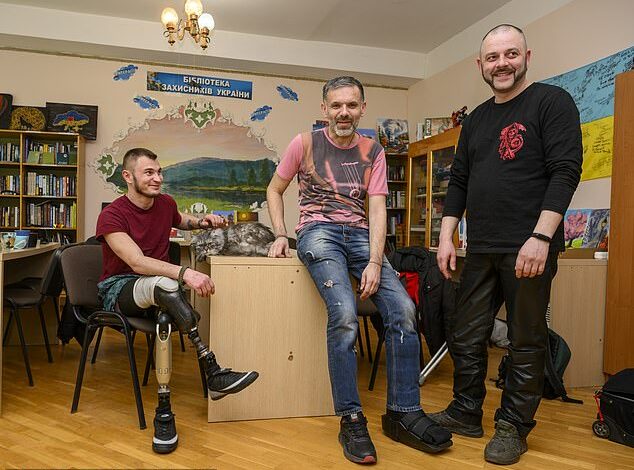The cats of war: Amid the carnage of the front line, Ukraine’s bravest fighters are finding solace by adopting strays who offer cuddles, comfort – and a lethal talent for clearing trenches of mice…

Murka is a timid little cat who lost a rear leg to Russian artillery fire in a frontline village in Donetsk.
She still won’t allow herself to be petted by the Ukrainian soldiers who tended her wounds and saved her life. But as she is a stray and no longer able to hunt efficiently, she is dependent on them for food.
And so Murka has become a ghostly, hopping presence on the margins of their field kitchen. The soldiers make sure she doesn’t go hungry.
Another cat, Dusia, was abandoned when her civilian owners fled the Russian advance and is now under the care of a fire support company of the frontline 41st Brigade.
Meanwhile, a tabby called Pixel has a new home in a bunker she shares with doting artillerymen.

Ukrainian soldiers Sasha, left, Andri and Roman at an animal therapy clinic where the cats help them to relax and reduce their depression

Tabby cat Pixel was a stray kitten when she was adopted by the 41st Brigade gunners. She now has a new home in a bunker she shares with artillerymen
Roman is an infantryman whose leg was shattered by machine gun fire in the summer fighting of 2022. We meet him in a psychological therapy unit at a military hospital in Kyiv. He tells a feline story from his own brigade.
‘A friend’s unit had a situation in which they forgot their cat,’ says Roman. ‘It happened during the usual chaos of rotation out of a forward position. But when they realised their mistake, they travelled 100 miles back to the same frontline location. It was actually something like a combat mission to retrieve their cat.’
He pauses to reflect on this extraordinary level of dedication. ‘Just to pick up a cat.’
I ask why his friend’s unit went to such trouble and risk. ‘Because the cat was by then a family member,’ Roman replies. In war, you don’t leave family members behind.
Murka, Dusia, Pixel and thousands of other former domestic pets are emblematic of the shattered communities that now exist across large swathes of Ukraine. The legacy of Putin’s invasion in February 2022.
Amid this brutal war, Ukraine’s soldiers’ relationships with such lost creatures may seem a frivolous, peripheral or overly-sentimental topic about which to write. But they throw a revealing light on the consolations to be gained from such connections in extremis and so we have made a film about the phenomenon for the Mail’s forthcoming Frontline Ukraine YouTube series.
In peacetime, Ukraine was a nation of pet owners, cats in particular. An estimated 9 million were kept by fewer than 50 million owners.
Mail cameraman Jamie Wiseman and I have covered the full Russian invasion of Ukraine since the first day. During the refugee exodus in early 2022, a common sight for us were the cats and small dogs being carried in travelling boxes or on shoulders among the millions of citizens who were fleeing the fighting.
In the initial panic, many other pets were left in frontline areas – or had to fend for themselves when their stay-behind owners were wounded, killed or removed by the Russian occupation forces.
Since then, some of these ‘red zone’ animals have been adopted by, or attached themselves to, frontline Ukrainian army units. Very often, while visiting a forward, or second line position, we have found at least one resident cat – or, less commonly, a dog – which the soldiers had come to consider to be an integral part of their unit.
How to explain this?
For tens of thousands of years Man has domesticated animals. A little more recently – from around 2500BC – we have exploited them for warfare: to supply our armies, help kill our enemies or warn us of hidden dangers.
Today, in Ukraine, the frontline relationship between man and beast is a little different; no longer focused on killing the enemy, but about mutual comfort, support, and the healing of trauma.
This symbiosis allows both soldier and animal to forget, for a little while at least, that they are still in some kind of hell. A man-made hell.

Kupi, a ginger tom, is robust and a champion mouser. The soldiers call him The Terminator as he kills the rodents scurrying around in the artillery dugouts

Dusia was found and adopted by Thunder Company of the 41st Brigade. She has become a Ukrainian army cat or ‘battle cat’
Take Dusia, for example. She has become a Ukrainian army cat, or ‘battle cat’, as someone here described her. We came across her in January, chasing a potato around the floor of a company HQ in an abandoned cottage on the Kupiansk front. Outside it was 20 degrees Celsius below zero.
Having fled Russian occupied territory, Dusia’s original civilian owners had left her at an animal shelter in central Ukraine. It was there she was found and adopted by Thunder company of the 41st Brigade.
The unit was in the process of being rebuilt away from the frontline having suffered catastrophic casualties in the defence of Bakhmut. Dusia had lost her home, while the soldiers had lost the majority of their comrades.
Last autumn, Dusia went with them to the Kupiansk frontline in Kharkiv oblast. More recently, she has been transferred with the 41st to the bitterly contested Chasiv Yar front.
One of the company’s officers explains why Dusia’s continued presence is important to his unit.
‘War destroys animals’ lives just as it destroys people’s lives,’ he says. ‘They are caught in the front-line zone where residents leave them behind when fleeing the war.
‘And so we find little kittens, little dogs, sometimes big ones. They will simply die without people. They cling to us, while we feed and carry them with us and in return they thank us by relieving stress and making us a little calmer.
‘Next to you is a living being that reminds you of a peaceful life, that does not talk to you about the war.’
He adds: ‘Dusia is always looking for care, affection and constant feeding. As if there is no war. Many units have cats and dogs. They are our medicine and our joy.’
Then he said something that would be repeated by a number of soldiers: ‘Unlike people, (these animals) are not treacherous, they are incapable of betrayal.’
Army cats are reminders of home. But they are also expected to do their own killing. In winter, frontline trenches and dugouts are often infested with rodents.
We came across Pixel and another cat called Kupi in an artillery dugout deep in the Kupiansk forest.
Pixel was a stray kitten when she was adopted by the 41st Brigade gunners. Now she lives alongside their self-propelled howitzers but has not got used to the sound of shellfire. Kupi, a ginger tom, is more robust and a champion mouser. The soldiers call him The Terminator.
But not every abandoned pet adopted by the Ukrainian military is feline. Bim was a traumatised stray dog, rescued by 56th Brigade soldiers in the Sloviansk sector.
Bim is very nervous and only trusts humans who wear uniform, the soldiers tell us. Certainly he shied away from us. The support is mutual.
‘This is Bim, our anti-stress dog which helps our guys protect ourselves from a psychological situation,’ one of the soldiers tells us, as Bim cowers behind him. ‘This dog eats too much and likes it when everyone touches him. He is like our white bear!’
Bucha is an abandoned Rottweiler who was adopted by the same brigade’s Mariupol Cossacks. Like Thunder Company of the 41st Brigade, they had sustained dreadful casualties.
We met Bucha on the Sloviansk front in January. She was very friendly and the soldiers clearly loved her. She was their mascot. But then, recently, and to their consternation, she vanished.
Kos, the young company commander, talks about the relationship with stray animals and the impact of Bucha’s loss.
‘We feed and often try to evacuate such animals from the front lines, just to save their lives,’ he says. ‘We ask the volunteers to bring the animal food to feed them.
‘Bucha stayed with us for almost a year. She knew every soldier in our unit and every soldier knew Bucha. She was a very friendly and gentle dog who was a comfort to everyone in this unit.
‘But she disappeared, literally dissolved in the air, one evening, around 8pm, when it got dark. We saw her playing, with another dog. And then she was gone.’
Several squads were assigned to search for Bucha, but with no success. She remains missing and the Mariupol Cossacks remain bereft.
Not every military pet is a former pet. Loki, for example, is a fox cub that was found in the bitterly contested border forests of northern Kharkiv by the Kraken special forces.
He was reared by hand and now has his own sleeping quarters and travelling case. A fox in a box.
This deep connection between soldiers and animals has been recognised by medical institutions. They need to harness it because many veterans here have simply lost faith in humanity.
Which is how we came to meet Boss, a five-year-old Persian-Siberian cross, and a number of other unexpected creatures who are helping traumatised Ukrainian soldiers with their mental recovery.
We were invited to the Askold Clinic at a military hospital which has helped hundreds of soldiers since the invasion.

Sasha, who lost both his legs to an explosion in the Donbas, pets five-year-old Persian-Siberian cross therapy cat Boss who helps traumatised Ukrainian soldiers with their mental recovery

Murka is a timid little cat who lost a rear leg to Russian artillery fire in a frontline village in Donetsk – she still does not allow herself to be petted by the Ukrainian soldiers who saved her
Large and extremely furry, Boss looks like the kind of creature you might see on a fashion shoot. In fact, he’s an important part of a medical unit that is helping Ukrainian soldiers recover from trauma.
Ukraine’s military has suffered thousands of physical casualties since the full Russian invasion of February 2022. But not all wounds are visible or can be healed in a matter of days or weeks.
The rehabilitation of combat soldiers suffering from PTSD and other war-related psychological issues is, and will long continue to be, one of the greatest challenges that faces Ukraine.
Animal-assisted therapy or zoo therapy, as I heard it called here in Kyiv, is a complementary approach to healing – or, better, coping with – a medical condition. It has been around in various guises since the 18th century.
This approach is based on the concept of the ‘human-animal bond’, which dates back to pre-history and is the foundation upon which so many of us keep domestic pets today.
Daria, a social worker at the Askold Clinic explains: ‘We use zoo therapy and we use ‘speaking with cats’ because it’s helping our defenders to relax and lower their depression. Through animals we can speak with them better because they do not always want to speak to us.’
We met three badly wounded veterans there. Sasha lost both his legs to an explosion in the Donbas. Andri, a furniture designer from Kyiv before he joined up after the 2022 invasion, now walks with a limp.
And there was the garrulous Roman. The war and his injury has altered, for the worse, his view of humanity – even of his fellow Ukrainians.
‘Returning to the rear areas, or walking through the capital itself, the war fundamentally changed the outlook of many people,’ he begins.
‘I have observed this in (my fellow soldiers) and, in the same way, I myself would sooner serve a piece of pie or some meat to a stray dog than communicate with a stranger.
‘Because, basically, all the guys understand what they’re fighting for. But with civilians, there is some aspect, well, we soldiers have already become different.
‘We now have very few topics for conversation with civilians. I have even met with old friends and there was nothing to talk about with them.’
Roman says he and his fellow veterans find it difficult even to speak to civilian medical professionals assigned to help them. ‘For example, only two to three months has passed since your injury and the same frontline is still there before your eyes,’ he says.
‘And here you go into the medical office and in front of you sits a beautiful girl, beautifully dressed, who begins to tell you how to deal with your problems. And you’re like, ‘What the f**k?’
‘But as soon as you grow sad, as soon as you give up like that – that’s the end.’
Which is where animal therapy comes in and has been successful – at the Askold at least. Kyiv zoo lends animals to the programme there, including racoons, sheep and even bats.
Zoo therapy doesn’t even have to include furry, hairy or even vertebrate creatures.
We find this out when boxes of large, shiny black cockroaches and skeletal stick insects – very much alive – are produced for us to handle.
One of the clinic staff tells us, ‘This is about being tactile, touching or otherwise interacting with something that is living but not human, because the trust and connection with fellow humans has been damaged by war.’
And how it has been damaged. ‘Any animal on the territory of this state is by default better than a living Russian,’ says Roman. ‘Even a viper, even a lizard, even mosquitoes. We even love our mosquitoes more than Russians now.’
Additional reporting by Oleksandr Kostiuchenko and Daria Bahlai.




